I've always enjoyed the idea of being a "Renaissance Man". In today's hyper-specialized world, it seems the best way to stand out is to be good at a number of things. It's also a great way to be able to relate to people of different professions, cultures, and walks of life.
So, every year, I try to pick something I haven't done before and spend the year learning about it. I may never go back to the subject after that year and I may never truly become knowledgeable about or good at it. But, I feel it's important for my own ongoing education. This year, I decided to take up a gardening. Specifically, I wanted to see what it'd be like to grow a bunch of herbs.
The Beginning
I grew up around a lot of plants - my mother is very into keeping houseplants. But, growing up, we never really had a garden. So, although I understood the gist of what I was getting into, I really didn't understand the specifics.
I started out with two basil plants: One of the typical "sweet" variety (that you're likely familiar with from traditional Italian cooking) and one of the "dark opal" variety (that you've probably never seen or heard of). I neglected to take pictures of these plants when I got them, but they were both more-or-less what you can apparently get from Lowes or Home Depot (they carry the Bonnie Plants products). I later grew some more from seed and cuttings for the complete experience but, to begin with, I skipped to the easy part: Keeping something alive that was already alive.
.) Dark Opal Basil](/images/2015/dark_opal_basil.jpg)
I almost failed magnificently about a week in... I live in Florida - there's a lot of sun, it's hot, and it rains very often. I figured this would be great for plants! So, I stuck both of my plants outside in their little pots. One morning, it rained. Then, the sun came out. And that's when my poor little plants burned to a crisp. I, again, neglected to take pictures...but, it was pretty gruesome.
In an effort to save them, I brought them in on the lanai. While I was waiting to see what would happen, I bought some seeds and planted them. It took a few weeks, but they eventually grew some more leaves and shed the crispy ones. The little seedlings went well, too, thankfully.

This is when I began taking cuttings to see if I could propagate the plants as well. This was fascinating for me and something I honestly didn't realize you could do. You literally slice a little branch off the plant, stick it in water, and it'll grow little roots! You can then re-plant the thing later and, as long as you're careful with it, it'll grow into a new plant!


The Problems
So, anyway, I wound up with a lot of little tiny plants all over the place. As a result, we wound up with a lot of basil. Naturally, this attracted a whole host of problems for me over the next few months. The internet has a number of resources for figuring out what these problems are that I'm pretty thankful for. I probably wound up with about half of them (along with some things that weren't problems, but thought they were). Here's some of the things I found helpful:
- Basil: An Herb Lover's Guide (cost ~$3.00 used)
- Plant Village's Basil Page
- Cornell University's Basil Diseases Fact Sheet
One of the first problems I ran into isn't a problem at all. I found that most of my basil were getting little knobs on their stems. These weird growths looked, to me, like maybe a little bug burrowing into the stem and eating my precious plants. Turns out, they're just aerial roots. If a basil is in a suitably humid environment (the entire state of Florida is pretty much a natural greenhouse, so mine definitely were), it'll trigger little root growths that won't actually go anywhere (since there's no soil or water). This is actually the same process that gets triggered during propagation...it just never completes.

Another non-problem (at least, for overall plant health) is stems becoming wooden. I thought I'd burned my plants again, but when the stem gets brown and hard, that's actually a natural part of the basil's growth. It is a little bit of a problem for harvesting, though. Once part of the stem is wooden, that segment will never grow buds again from that section. You'll have to make sure you cut well above it or you'll risk killing the plant later.

My first real problem turned out to be cabbage loopers. I noticed a number of my plants' leaves getting holes in them, but could never figure out what was eating them. A few online resources had mentioned going out at night and checking under leaves. Bugs tend to be more active then and often hide under the leaves to avoid being eaten. I eventually found one of the little worms and, once I knew what I was looking for, found them on every plant.
Since most of my plants were still in pots (I'm renting the house I live in - not a homeowner yet!), I watered them, turned them upside down, and dunked them in soapy water. This basically drowned the poor worms, ensuring that none of them were remained on my basil. I picked the rest off of the others. Unfortunately, a number of plants had lost a lot of leaves to the worms and didn't make it.


I also had problems with three other bugs: Leaf miners, thrips, and scale. These caused me considerable distress as I watched my poor little plants slowly lose leaves and stems. And, in the case of the thrips, I again had a very hard time discerning what was actually causing the problem. (They make little holes and suck the juices out, which wilts the leaf slowly. It almost looks like they're dying to a weird mold, rather than a bug. You can actually see some of this in the picture above with the small cabbage looper worm.)
Up until this point, I'd just been growing stuff - no fertilizer, no pesticides. I wound up finding azadirachtin, though, and used that. Azadirachtin is a compound found in the oil of the Neem tree. When ingested by a bunch of different bugs (to include leaf miners, thrips, and scale...but excluding good stuff like ladybugs, butterflies, and honey bees), it causes them to no longer be hungry. This causes them to either leave the plant or stay and starve to death. I needed to continue reapplying it every 3-4 weeks, but it was super-effective! I used a small portion of a small bottle over an entire summer.
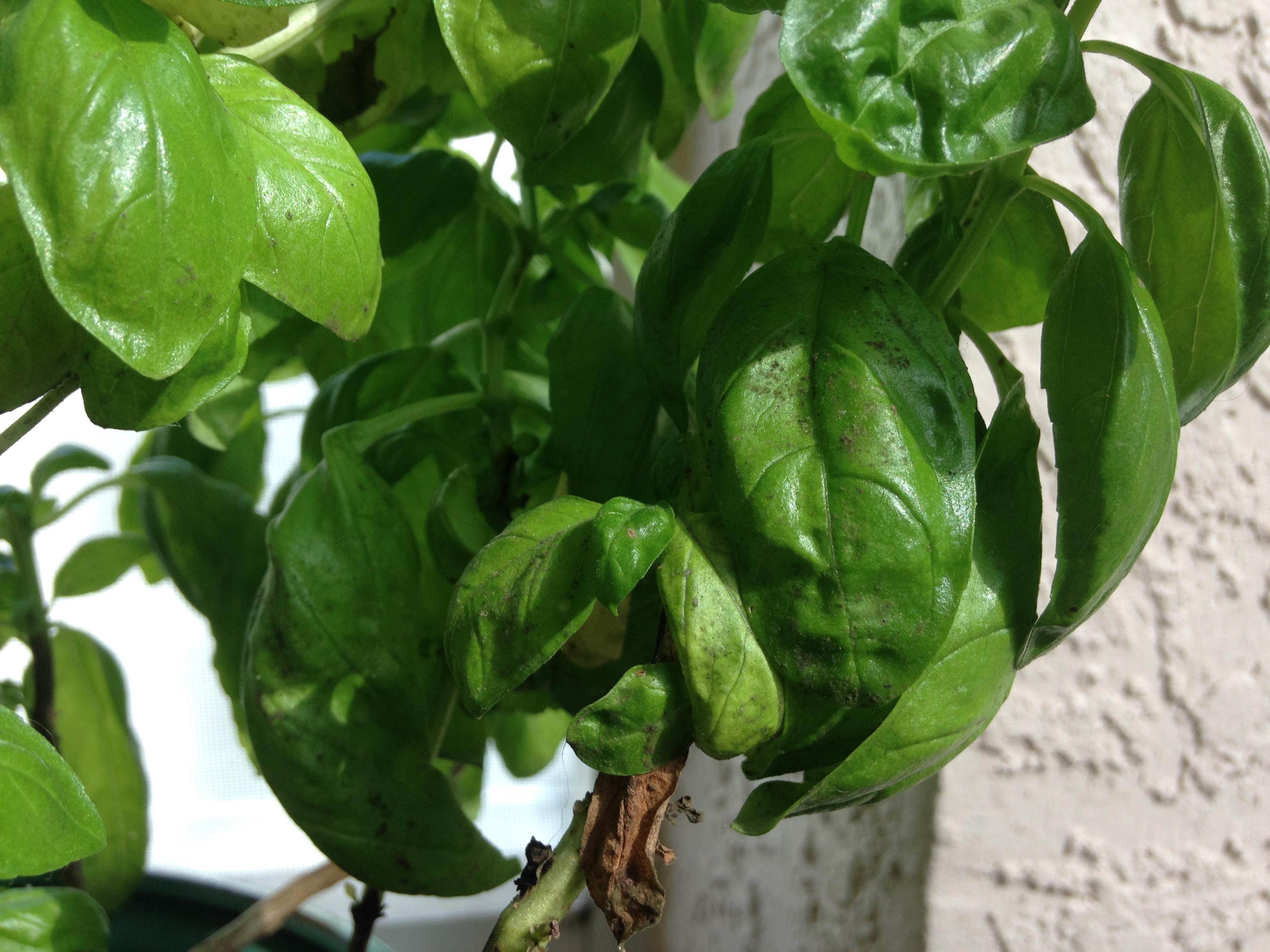



I also had some minor problems with leaf spot. Fortunately, this only ever affected single leaves at a time for me. Removing the affected leaves seemed to prevent any lasting epidemic of the stuff. As a result, I never really did a lot of research into why I was getting leaf spot or how to more permanently treat it.

Another problem I had later on in the growing season was having plants try to go to seed. Basil plants grow in segments. Each of these segments is separated by a little bud. These buds will turn into leaf pairs unless the segment above it is cut. If it is, it'll grow into a new branch. This is how you harvest basil: You continue cutting the plant stems right above a leaf pair, then let the leaf pairs grow into two new segments.
You can't really get more than ~7 or so segments to grow in a row, though. Once you get around that many, the plant decides that it's done its job and needs to prepare for the next generation of basil plants. So, it grows a little flower. These flowers are pretty, but also horrible if you want more basil. Once the basil plant successfully grows its flowers and puts out seeds, it'll stop putting out new leaves. It is, therefore, extremely important to snip these flowers off before they get anywhere.
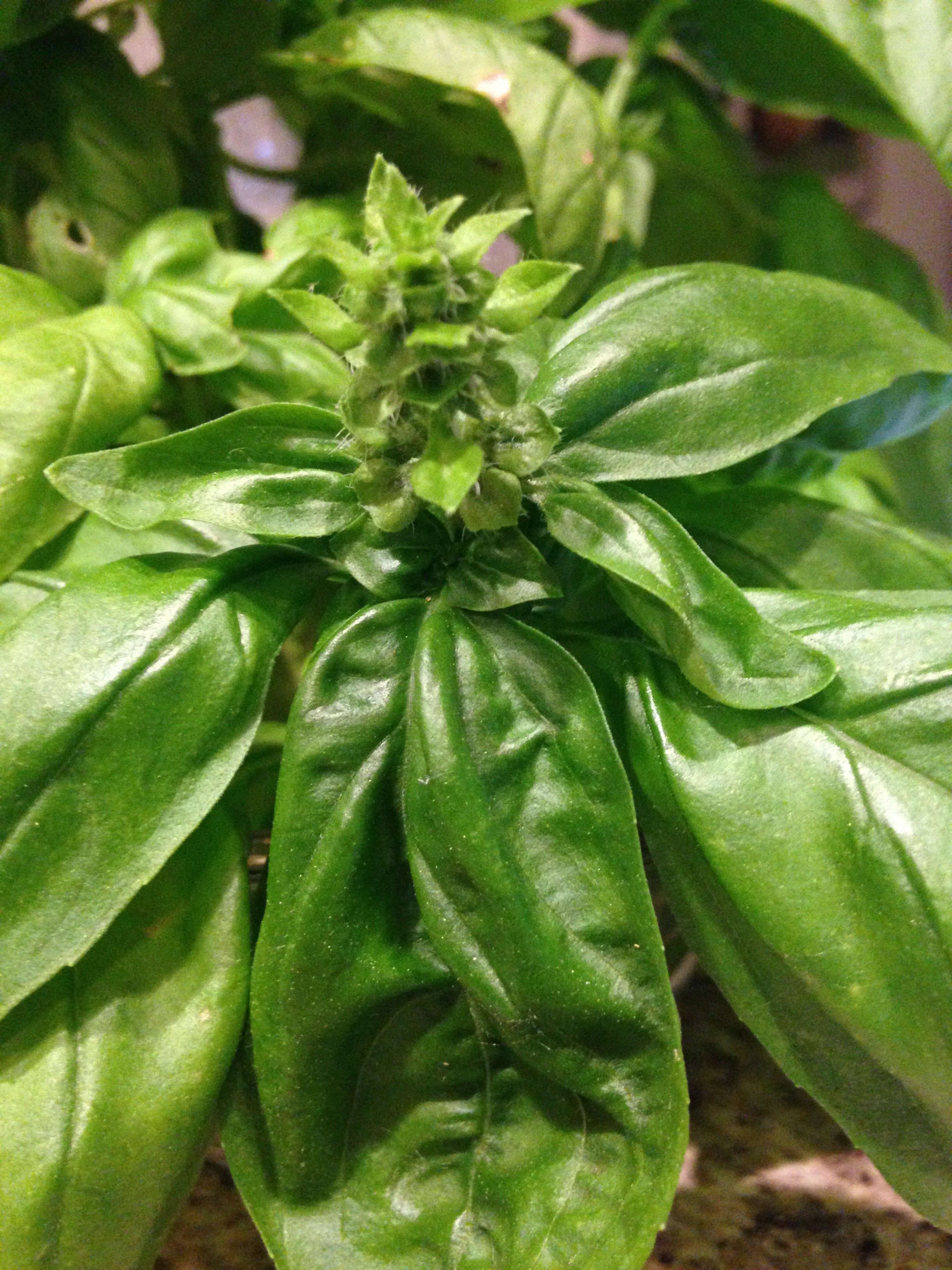
The last problem I had also wasn't really an issue. Most of my "dark opal" basil plants wound up having mottled green and purple leaves instead of the dark purple leaves I was expecting (like in the picture toward the beginning of this post). I was very concerned about this, but it turns out it may have something to do with the growing conditions of Florida.
From reading online (and a bit of experimentation), it appears the "dark opal" variety of basil tends to be lighter and greener in hot temperatures. Florida in the spring and summer is, of course, quite hot. As a result, leaves tended to be far less purple and far more green than I'd hoped for. There also seems to be a tendency for "dark opal" seedlings to revert to a more greenish color, which suggests the mutation for the purple color might be a recessive trait. Again, the internet seems to corroborate this theory.
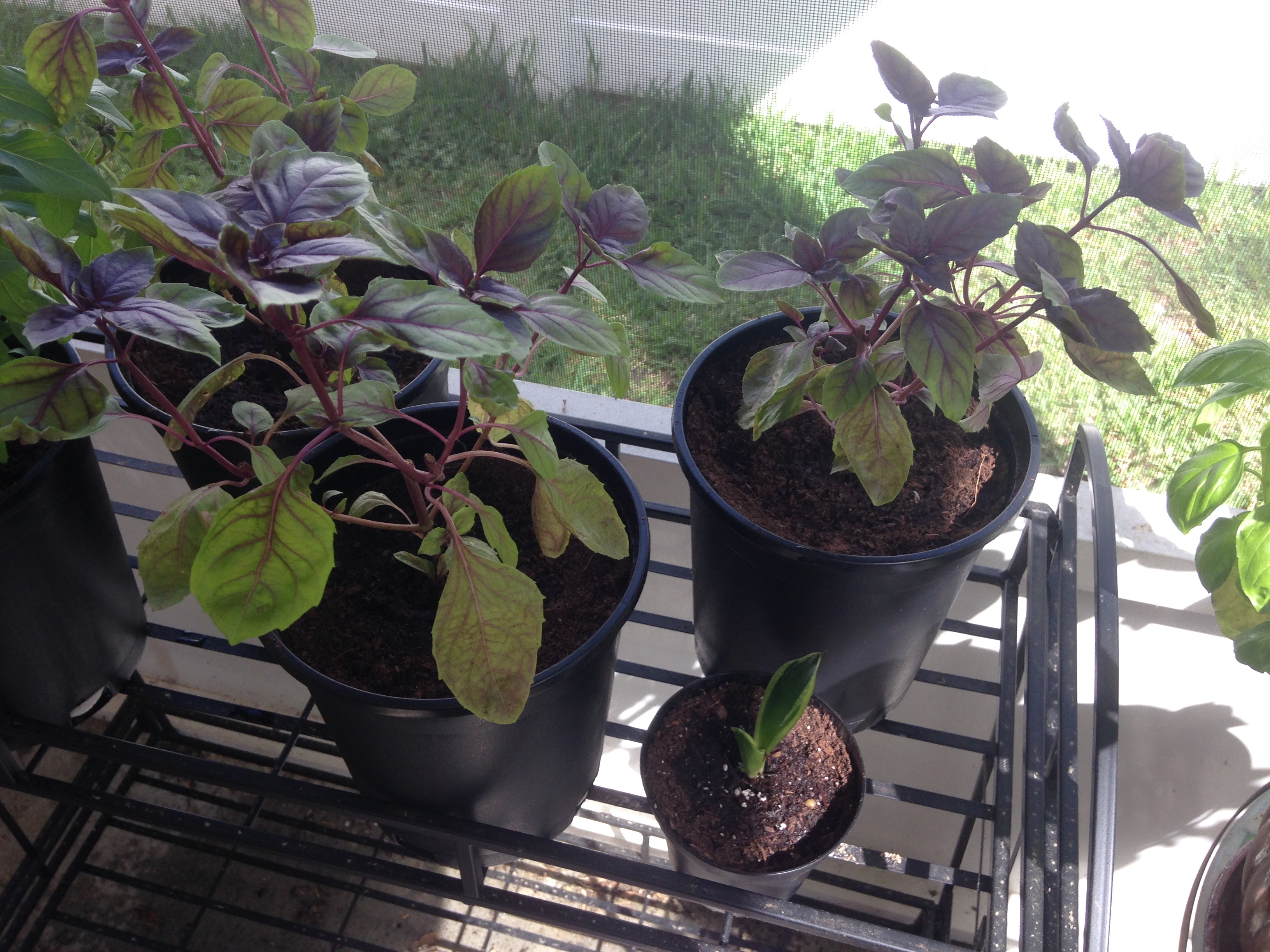
The End
By mid-summer, I'd been doing extremely well! The vast majority of my plants never died and I wound up with a large assortment of them. I experimented with other types of herbs in addition to basil including:
- Thai Basil
- Cinnamon Basil
- Garden Sage
- Italian and Greek Oregano
- Curly Parsley
- Spearmint
- Peppermint
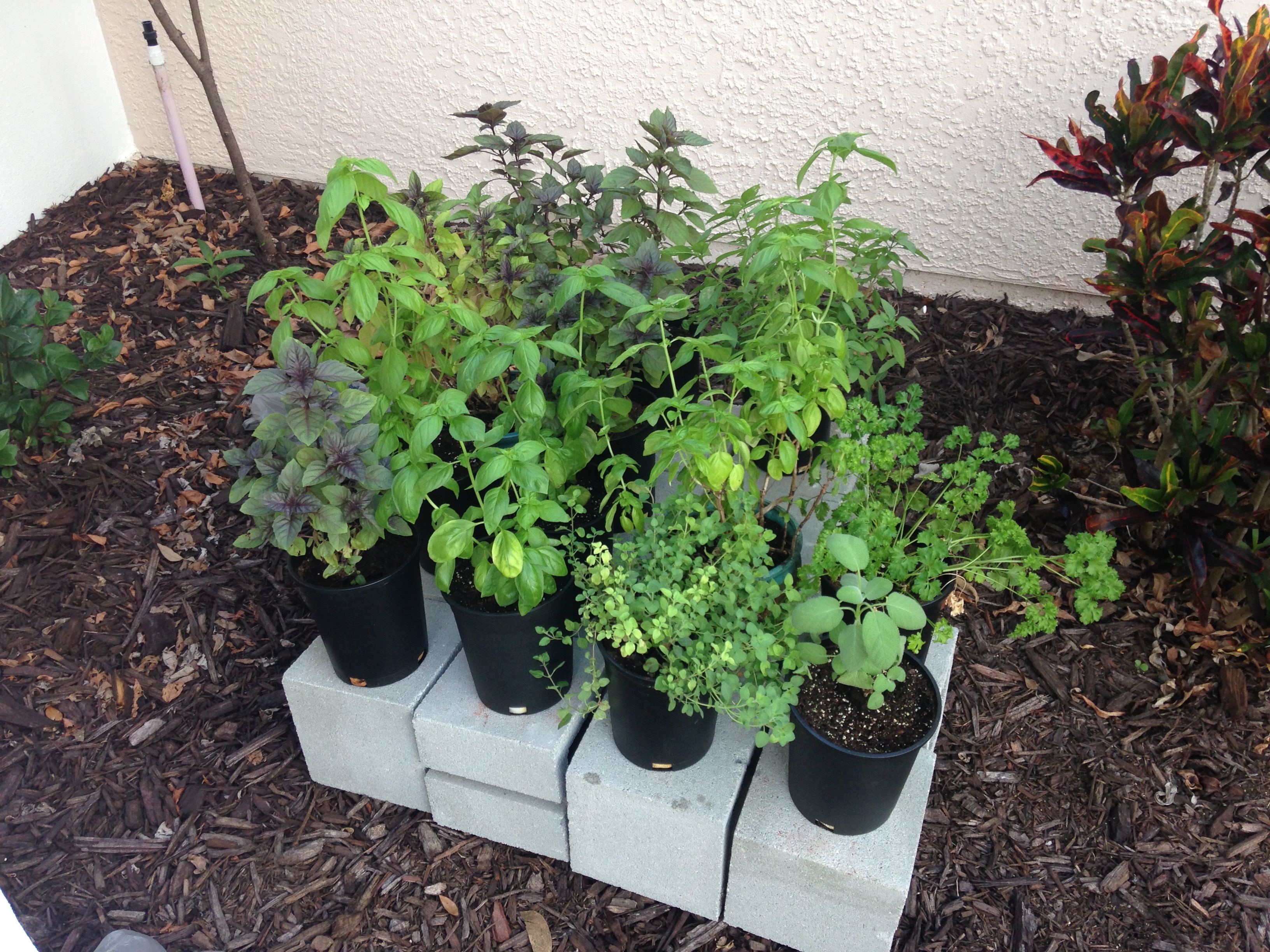
A large amount of these herbs went toward cooking (particularly the parsley, oregano, and basil). The rest mostly went toward herbal tisanes. I'm a huge fan of tea, so getting to steep fresh leaves from different plants was a really exciting experience for me. The funny looks I'd get when dragging a whole bunch of fresh basil cuttings into work were also priceless.
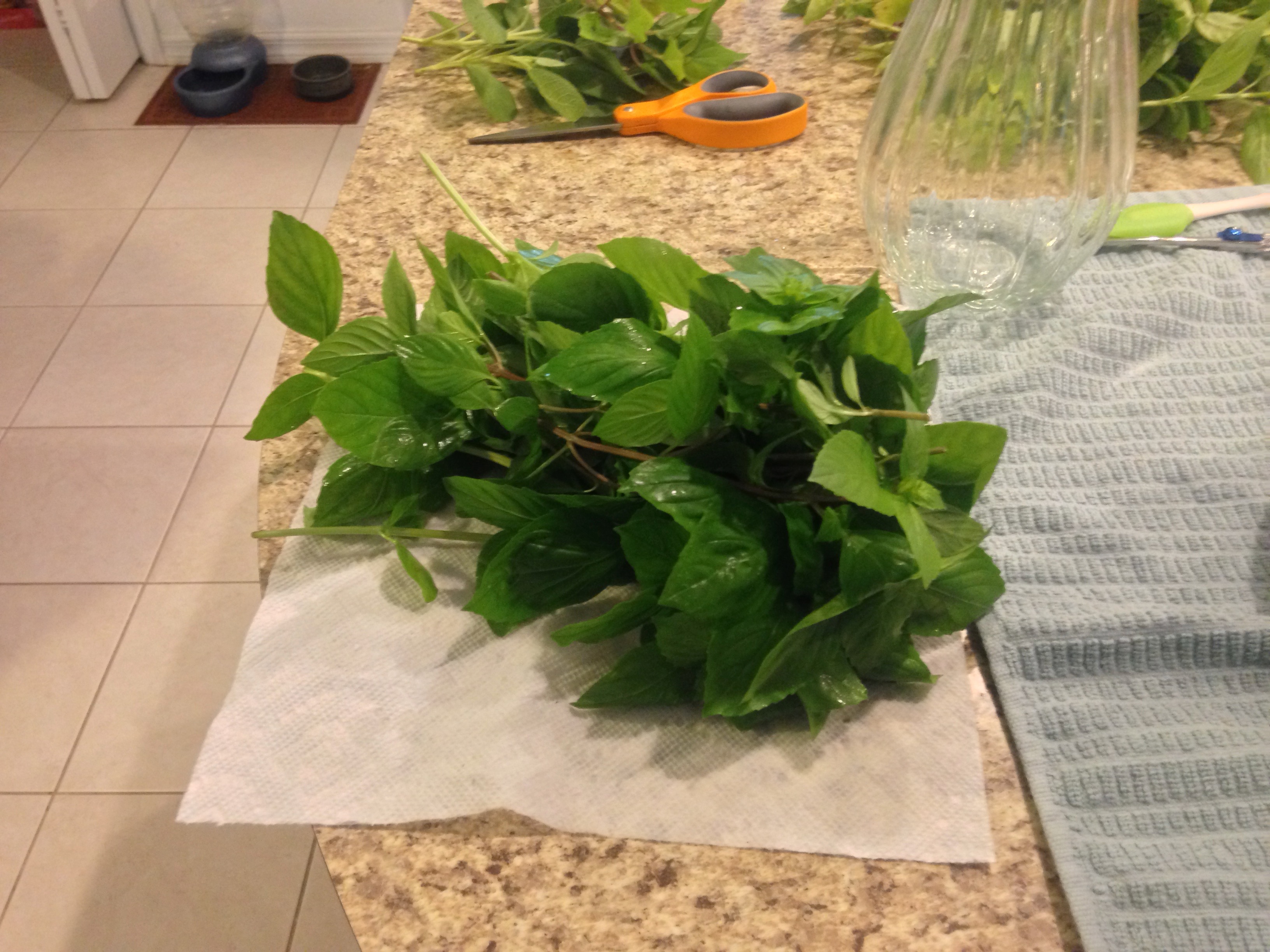
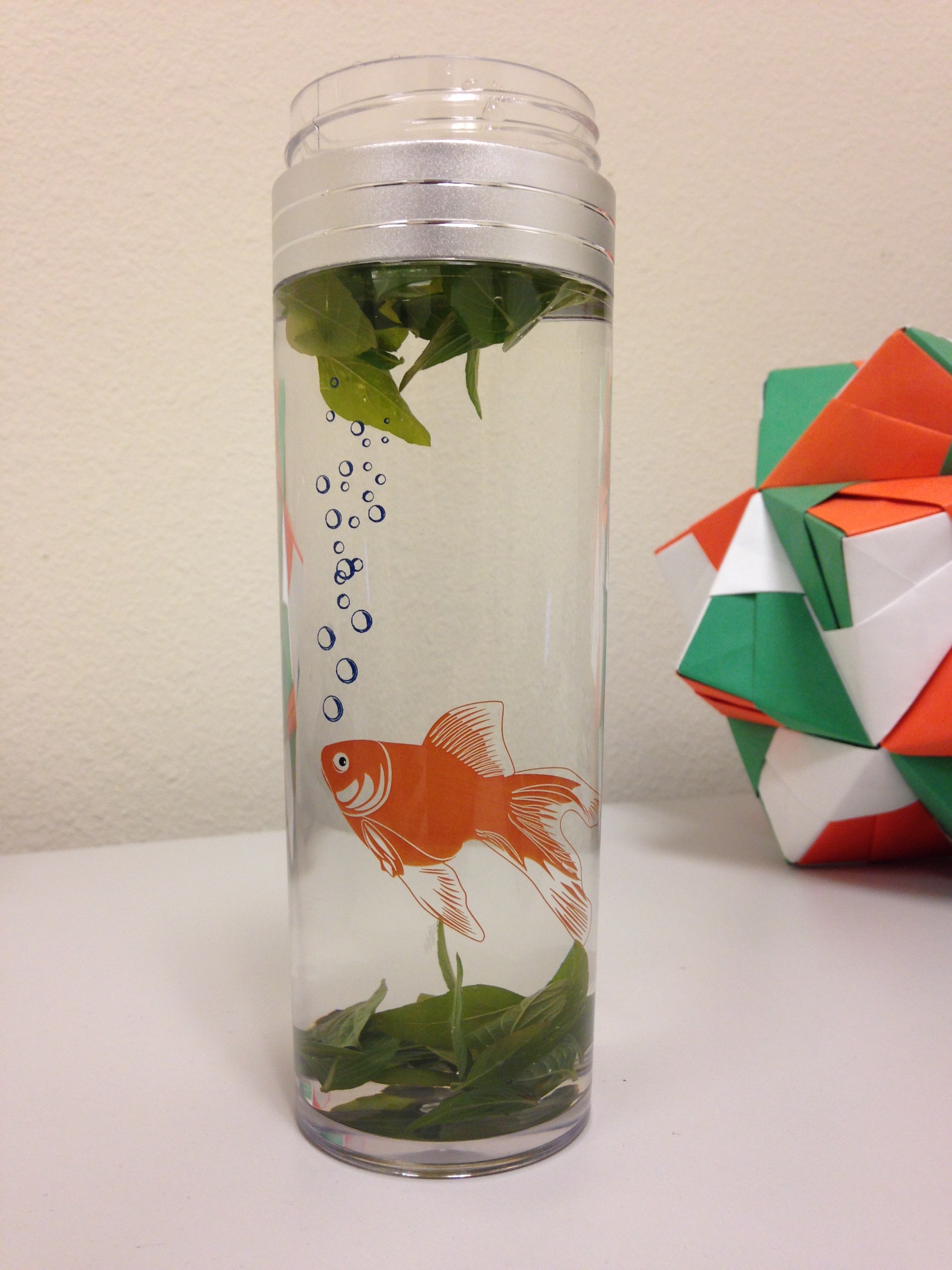
Sadly, although I was having a ridiculous amount of fun growing things, I had to leave for a month of travel. I asked a neighbor to water all my plants every 2-3 days while I was gone. We were out of the rainy season and, since most of the plants were not actually in the ground (like I said, we're renting the house we currently live in, so I can't do any real landscaping), there was a significant risk of them shriveling up and dying. Before I left, I also made an effort to ensure their survival anyway. I placed a number of them near sprinklers, cut all of them back as far as I could (to prevent moisture loss through their leaves), and tried to get them out of intense, direct sunlight.
Alas, when I returned, it was to a large number of very dead plants. Over 75% of the plants I'd left had died since my neighbor neglected to water them (some at all, others in a timely fashion). The rest, mostly basil, had grown way too fast and had gone to seed. As a result, they were no longer harvestable. As of right now, not much is left - only a few little sad and struggling mint plants that I've been slowly trying to revive.
Overall, this was an incredibly fun experience and I'm glad to have done it...even if it ended in sadness. That said, I've decided I'm definitely not doing this again until I've got my own house. Growing everything in pots was annoying and I'm confident many of my herbs would have survived if they weren't in pots. It's going to suck to not have fresh basil tea available every day, though...

